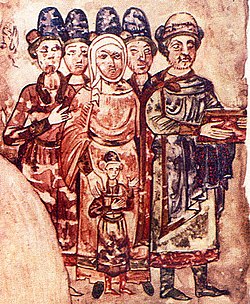Top Qs
Timeline
Chat
Perspective
December 27 (Eastern Orthodox liturgics)
Day in the Eastern Orthodox liturgical calendar From Wikipedia, the free encyclopedia
Remove ads
December 26 - Eastern Orthodox liturgical calendar - December 28

All fixed commemorations below are observed on January 9 by Eastern Orthodox Churches on the Old Calendar.[note 1]
For December 27th, Orthodox Churches on the Old Calendar commemorate the Saints listed on December 14.
Feasts
Saints
- Archdeacon Stephen the Protomartyr (34)[1][3][4]
- Saint Maximus, Pope of Alexandria (282)[1][5][note 3][note 4]
- Martyrs Maurice, with his son Photinus, and 70 soldiers, at Apamea (286-305)[1][8][note 5] (see also: February 22)
- Saint Theodore, Patriarch of Constantinople (686)[1][9][10]
- Venerable Theodore the Branded (Theodore Graptus), of Palestine and Bithynia, Confessor (840)[1][11][12][note 6][note 7]
- Venerable Luke, Abbot of the Monastery of the Deep Stream in Triglia, in Bithynia.[1][13][note 8]
Remove ads
Pre-Schism Western saints
Post-Schism Orthodox saints
- Venerable Abbot Boniface (Vinogradsky), founder of St. Panteleimon Monastery, Kiev (1871)[15][16][note 10]
New martyrs and confessors
Other commemorations
- Uncovering of Relics (1514) of Venerable Pherapont (Therapont) of Mozhaisk, Luzhetsk.[5][17][19] (see also: May 27 - feast day.)
- Repose of Nicholas Ilminsky, Missionary to the Tatars (1891)[1]
- Repose of Archimandrite Agathangelus of Svir and Valaam (1909)[1]
- Repose of Helen Ivanovna Motovilova (1910)[1]
- Repose of Abbot Athanasius of Grigoriou Monastery, Mt. Athos (1953)[1]
- Repose of Archimandrite Seraphim (Rozenberg) of the Pskov-Caves Monastery (1993)[1]
Remove ads
Icons
- Icon of the Mother of God "the Merciful".[17][20]
Icon gallery
- Russian icon of Protomartyr Archdeacon Stephen
(16th century) - Saint Sviatoslav II of Kiev (far right), with his family.
Notes
- The notation Old Style or (OS) is sometimes used to indicate a date in the Julian Calendar (which is used by churches on the "Old Calendar").
The notation New Style or (NS), indicates a date in the Revised Julian calendar (which is used by churches on the "New Calendar"). - He participated in the Synod of Antioch against the teachings of Paul of Samosata.[6]
- The Greek text states that this Apamea was in Bithynia, of Pontus - ((in Greek): Ἀπάμεια τῆς Βιθυνίας τοῦ Πόντου).
- Brother of St. Theophanes the Confessor and Hymnographer.
- "At Constantinople, the holy confessors Theodore and Theophanes, brothers, who were brought up from their childhood in the Monastery of St. Sabbas. Afterwards, combating bravely for the worship of holy images against Leo the Armenian, they were scourged by his command and banished. After his death, they again firmly opposed the emperor Theophilus, who was imbued with the same impiety, and were scourged a second time and driven into exile, where Theodore expired in prison. Theophanes, after peace had at length been restored to the Church, was made bishop of Nicea and rested in the Lord."[7]
- A patrician in Rome who married and divorced. She married again, causing scandal. After the death of her second husband, she repented and devoted her wealth to the care of the sick in a hospital which she established. She also founded a hostel for pilgrims in Rome and was greatly venerated.[14]
- "On February 20, 2011, on the Sunday of the Prodigal Son, His Beatitude Metropolitan Vladimir of Kiev and All Ukraine presided over the solemn canonization of Abbot Boniface (Vinogradsky) (+ December 27, 1871), the founder of the St. Panteleimon Monastery in Feofania (Kiev) and ascetic of piety, reports Patriarchia.ru. Abbot Boniface is now a locally canonized saint of the Ukrainian Orthodox Church."[15]
Remove ads
References
Sources
Wikiwand - on
Seamless Wikipedia browsing. On steroids.
Remove ads





